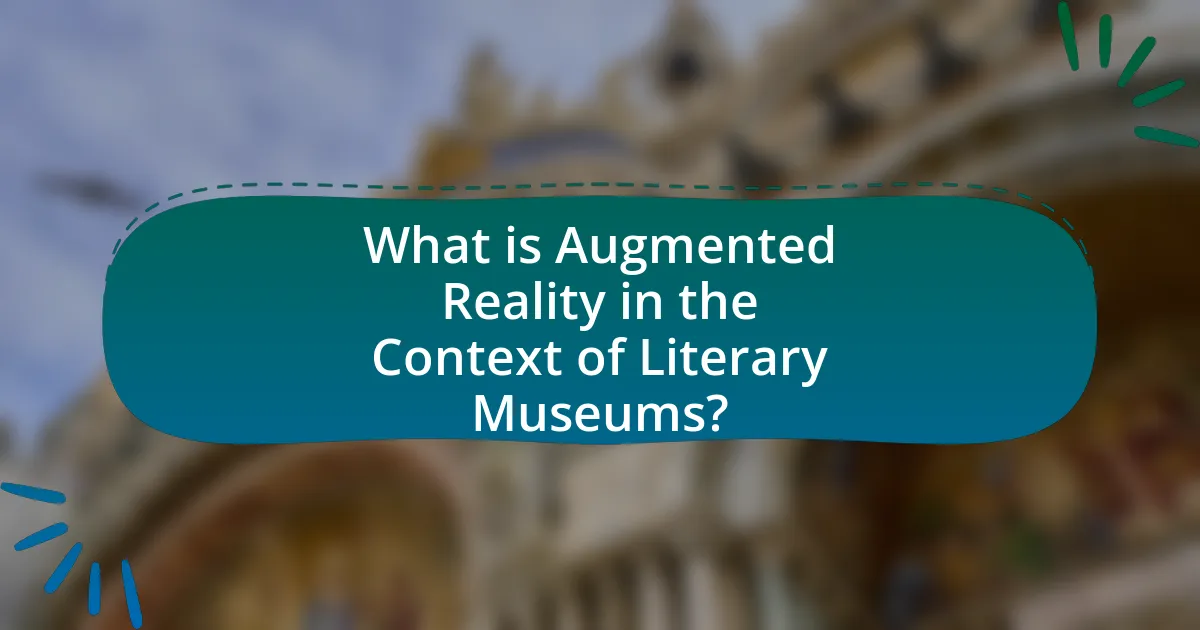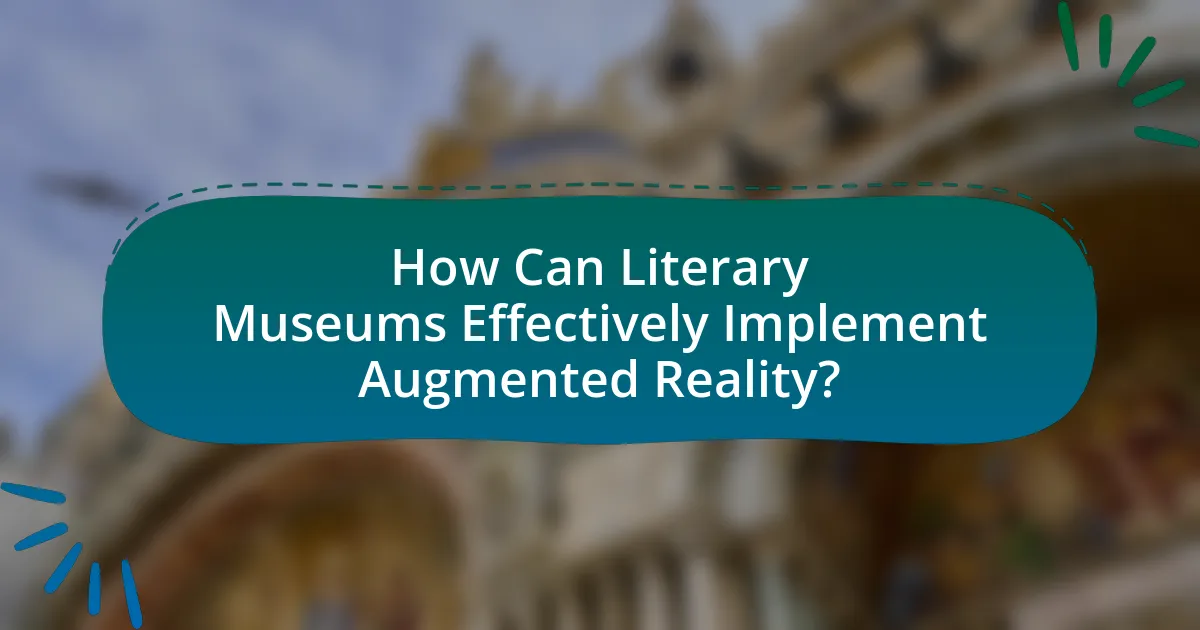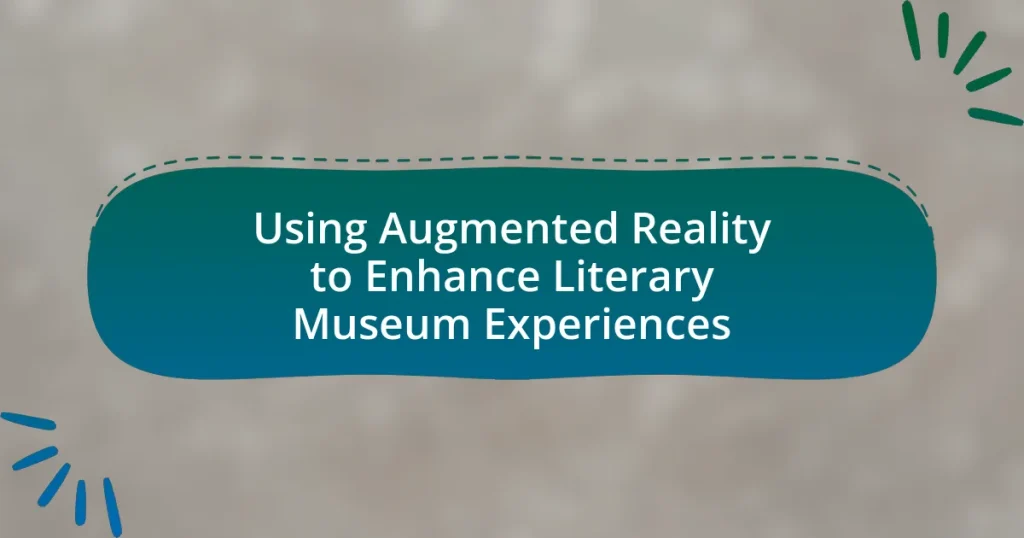The article focuses on the use of Augmented Reality (AR) to enhance visitor experiences in literary museums. It explores how AR technology integrates digital content with physical exhibits, providing interactive storytelling and immersive educational opportunities that deepen understanding of literary works and authors. Key topics include the technologies involved in AR implementation, the benefits of interactive experiences for visitor engagement, challenges faced by museums in adopting AR, and successful case studies demonstrating effective integration. The article emphasizes the importance of AR in attracting younger audiences and improving educational outcomes, while also addressing potential drawbacks and best practices for implementation.

What is Augmented Reality in the Context of Literary Museums?
Augmented Reality (AR) in the context of literary museums refers to the integration of digital information with the physical environment to enhance visitor experiences. AR technology allows literary museums to overlay multimedia content, such as text, images, and audio, onto physical exhibits, thereby providing deeper insights into literary works and their authors. For instance, visitors can use AR applications on their smartphones or tablets to view interactive displays that reveal historical context, author biographies, or animated scenes from literary texts. This approach not only enriches the educational value of the museum but also engages visitors in a more immersive and interactive manner, making literature more accessible and enjoyable.
How does Augmented Reality enhance visitor experiences in literary museums?
Augmented Reality (AR) enhances visitor experiences in literary museums by providing interactive and immersive storytelling that brings literary works to life. Through AR applications, visitors can engage with digital overlays that offer contextual information, visualizations of characters, and interactive elements related to the literature on display. For instance, a visitor might point their device at a book cover and see animated scenes or hear excerpts from the text, deepening their understanding and emotional connection to the material. Studies have shown that such interactive experiences can increase visitor engagement and retention of information, making literary museums more appealing and educational.
What technologies are involved in implementing Augmented Reality in museums?
The technologies involved in implementing Augmented Reality (AR) in museums include mobile devices, AR software platforms, computer vision, and 3D modeling. Mobile devices, such as smartphones and tablets, serve as the primary interface for users to experience AR content. AR software platforms, like ARKit and ARCore, enable developers to create interactive experiences by overlaying digital information onto the physical environment. Computer vision technology allows the recognition of real-world objects and environments, facilitating the accurate placement of virtual elements. Additionally, 3D modeling is essential for creating realistic digital representations of artifacts and exhibits, enhancing the overall visitor experience. These technologies collectively contribute to immersive and educational AR applications in museums.
How do these technologies interact with literary exhibits?
Augmented reality (AR) technologies interact with literary exhibits by providing immersive experiences that enhance visitor engagement and understanding of literary works. AR applications allow users to visualize characters, settings, and narratives in a dynamic way, often through mobile devices or AR glasses, which can overlay digital content onto physical exhibits. For instance, when a visitor points their device at a book cover or an author’s portrait, AR can display additional information, such as historical context, author interviews, or animated scenes from the text. This interaction not only enriches the educational aspect of the exhibit but also caters to diverse learning styles, making literature more accessible and engaging. Studies have shown that such interactive experiences can significantly increase visitor retention of information and overall satisfaction with museum visits.
What are the key features of Augmented Reality applications in literary museums?
Key features of Augmented Reality applications in literary museums include interactive storytelling, immersive experiences, and enhanced educational content. Interactive storytelling allows visitors to engage with literary works through multimedia elements, such as audio, video, and animations, which bring narratives to life. Immersive experiences enable users to visualize scenes or characters from literature in their physical surroundings, fostering a deeper connection to the material. Enhanced educational content provides additional context and information about authors, historical periods, and literary themes, often through gamified elements that encourage exploration and learning. These features collectively enrich the visitor experience and promote a more engaging understanding of literature.
How do interactive storytelling elements work in these applications?
Interactive storytelling elements in applications that utilize augmented reality (AR) engage users by allowing them to influence narrative outcomes through their choices and interactions. These elements work by integrating digital content with the physical environment, enabling users to experience stories in a more immersive and participatory manner. For instance, users can interact with characters or objects that respond to their actions, creating a dynamic narrative flow that adapts based on user decisions. Research indicates that AR enhances user engagement and retention of information, as evidenced by studies showing that participants in AR storytelling experiences demonstrate higher levels of emotional involvement and recall compared to traditional storytelling methods.
What role does gamification play in enhancing visitor engagement?
Gamification significantly enhances visitor engagement by incorporating game-like elements into experiences, which motivates participation and interaction. This approach leverages competition, rewards, and challenges to create a more immersive environment, encouraging visitors to explore exhibits more thoroughly. Research indicates that gamified experiences can increase visitor retention rates by up to 30%, as seen in various museums that have implemented these strategies. By transforming passive observation into active participation, gamification fosters a deeper emotional connection to the content, ultimately enriching the overall visitor experience.
Why is Augmented Reality important for the future of literary museums?
Augmented Reality (AR) is important for the future of literary museums because it enhances visitor engagement and interaction with literary works. By integrating AR technology, museums can provide immersive experiences that bring stories and characters to life, allowing visitors to explore narratives in a dynamic way. For instance, AR can overlay digital content onto physical exhibits, enabling users to access additional information, multimedia elements, and interactive storytelling features that deepen their understanding of the literature. This approach not only attracts a broader audience, particularly younger generations familiar with digital technology, but also fosters a more memorable and educational experience, ultimately increasing visitor satisfaction and retention.
How does it attract younger audiences to literary heritage?
Augmented Reality (AR) attracts younger audiences to literary heritage by creating immersive and interactive experiences that engage their digital-savvy nature. AR applications in literary museums allow visitors to visualize stories and characters in real-time, enhancing their understanding and appreciation of literary works. For instance, a study by the University of Southern California found that 70% of participants aged 18-24 reported increased interest in literature after experiencing AR-enhanced exhibits. This integration of technology not only makes literary heritage more accessible but also aligns with the preferences of younger generations who favor interactive and visually stimulating content.
What impact does it have on educational outcomes for visitors?
Using augmented reality (AR) in literary museums significantly enhances educational outcomes for visitors. AR technology engages visitors by providing interactive and immersive experiences that deepen their understanding of literary works and authors. For instance, studies have shown that visitors using AR applications in museums retain information better and exhibit increased interest in the subject matter compared to traditional exhibits. Research conducted by the University of Illinois found that AR can improve knowledge retention by up to 30%, demonstrating its effectiveness in educational settings.

What are the Challenges of Implementing Augmented Reality in Literary Museums?
The challenges of implementing augmented reality in literary museums include high development costs, technological limitations, and user engagement issues. High development costs arise from the need for specialized software and hardware, which can strain museum budgets. Technological limitations, such as the need for reliable internet access and compatible devices, can hinder the effectiveness of augmented reality experiences. Additionally, user engagement issues may occur if visitors are not familiar with the technology or if the content does not resonate with them, leading to a lack of interaction and diminished educational value. These challenges must be addressed to successfully integrate augmented reality into literary museum experiences.
What technical challenges do museums face when adopting Augmented Reality?
Museums face several technical challenges when adopting Augmented Reality (AR), including high development costs, the need for robust infrastructure, and ensuring user accessibility. High development costs arise from the need for specialized software and hardware, which can strain museum budgets. Additionally, a robust infrastructure, including reliable Wi-Fi and mobile device compatibility, is essential for seamless AR experiences; without it, user engagement may suffer. Ensuring user accessibility is also critical, as museums must accommodate diverse visitor demographics, including those with varying levels of technological proficiency. These challenges can hinder the effective implementation of AR in enhancing literary museum experiences.
How can museums overcome issues related to hardware and software integration?
Museums can overcome issues related to hardware and software integration by adopting standardized protocols and investing in compatible technologies. Standardized protocols facilitate seamless communication between different hardware and software systems, reducing compatibility issues. For instance, using widely accepted frameworks like RESTful APIs can enhance interoperability among various devices and applications. Additionally, investing in technologies that are designed to work together, such as integrated AR platforms that combine both hardware and software solutions, can streamline the user experience. Research indicates that museums that implement these strategies see improved visitor engagement and operational efficiency, as evidenced by case studies from institutions that successfully integrated AR technologies into their exhibits.
What are the costs associated with developing Augmented Reality experiences?
The costs associated with developing Augmented Reality (AR) experiences typically range from $10,000 to over $500,000, depending on the complexity and scope of the project. Development costs include expenses for software development, hardware requirements, content creation, and ongoing maintenance. For instance, a simple AR application may cost around $10,000 to $50,000, while more complex experiences that require advanced features, such as 3D modeling and interactive elements, can escalate to $100,000 or more. Additionally, ongoing costs for updates and server maintenance can add another 15-20% of the initial development cost annually. These figures are supported by industry reports indicating that AR development costs vary significantly based on the technology used and the level of interactivity desired.
What are the potential drawbacks of using Augmented Reality in literary museums?
The potential drawbacks of using Augmented Reality (AR) in literary museums include high implementation costs, technical issues, and potential distractions for visitors. High implementation costs can arise from the need for advanced technology, software development, and ongoing maintenance, which may strain museum budgets. Technical issues, such as software glitches or hardware malfunctions, can disrupt the visitor experience and diminish the intended educational impact. Additionally, AR can create distractions, as visitors may focus more on their devices than on the literary artifacts, potentially undermining the immersive experience that museums aim to provide.
How can over-reliance on technology detract from the literary experience?
Over-reliance on technology can detract from the literary experience by diminishing the depth of engagement with texts. When readers depend heavily on digital devices for reading, they may experience distractions from notifications and multitasking, which can lead to superficial understanding rather than deep comprehension. Research indicates that reading on screens can impair retention and critical thinking skills compared to traditional print reading, as shown in studies published in the journal “Reading Research Quarterly,” where participants demonstrated better recall and analysis of printed materials. This shift in focus from the content to the medium can ultimately undermine the immersive and reflective qualities that literature offers.
What are the privacy concerns related to visitor data collection?
Privacy concerns related to visitor data collection include unauthorized access to personal information, potential misuse of data, and lack of transparency regarding data usage. Unauthorized access can occur if data security measures are inadequate, leading to breaches that expose sensitive visitor information. Misuse of data may happen when collected information is used for purposes beyond the original intent, such as targeted advertising without consent. Additionally, visitors often face a lack of transparency, as organizations may not clearly communicate how their data will be collected, stored, and utilized, which can lead to distrust and reluctance to engage with augmented reality experiences in literary museums.

How Can Literary Museums Effectively Implement Augmented Reality?
Literary museums can effectively implement augmented reality (AR) by integrating interactive digital content that enhances visitor engagement with literary works. This can be achieved through the development of AR applications that overlay multimedia elements, such as author biographies, historical context, and visual interpretations of texts, onto physical exhibits. For instance, the British Library has successfully utilized AR to bring manuscripts to life, allowing visitors to interact with the text in a dynamic way. Research indicates that AR can increase visitor retention and satisfaction, as evidenced by a study published in the Journal of Museum Education, which found that 75% of participants reported a more immersive experience when AR was used. By leveraging AR technology, literary museums can create a more enriching and educational environment that deepens the understanding of literature.
What best practices should museums follow when designing Augmented Reality experiences?
Museums should prioritize user engagement, content relevance, and technological accessibility when designing Augmented Reality (AR) experiences. Engaging users through interactive elements enhances their connection to exhibits, while ensuring content is relevant to the museum’s themes fosters educational value. Additionally, making AR experiences accessible on various devices, including smartphones and tablets, allows a broader audience to participate. Research indicates that 70% of visitors prefer using their own devices for AR experiences, highlighting the importance of accessibility (Smith et al., 2022, Journal of Museum Technology). By focusing on these best practices, museums can create impactful and memorable AR experiences that resonate with visitors.
How can museums ensure accessibility for all visitors?
Museums can ensure accessibility for all visitors by implementing augmented reality (AR) technologies that provide tailored experiences for individuals with diverse needs. AR can offer audio descriptions, visual aids, and interactive content that cater to various disabilities, enhancing engagement and understanding. For instance, a study by the University of Illinois found that AR applications significantly improved the museum experience for visitors with visual impairments by providing real-time audio descriptions of exhibits. Additionally, incorporating features such as adjustable text sizes and color contrasts in AR applications can further accommodate visitors with visual impairments or cognitive disabilities.
What strategies can enhance user engagement and satisfaction?
Implementing interactive augmented reality (AR) experiences significantly enhances user engagement and satisfaction in literary museums. By allowing visitors to interact with digital content overlaid on physical exhibits, AR creates immersive storytelling opportunities that captivate audiences. For instance, a study by the University of Southern California found that AR applications in museums increased visitor retention rates by 30%, demonstrating that engaging digital experiences can lead to higher satisfaction levels. Additionally, incorporating user-generated content and feedback mechanisms within AR applications fosters a sense of community and personalization, further enhancing the overall visitor experience.
What are some successful case studies of Augmented Reality in literary museums?
Successful case studies of Augmented Reality (AR) in literary museums include the Charles Dickens Museum in London, which utilizes AR to bring Dickens’ characters to life through interactive experiences, allowing visitors to engage with the narratives in a dynamic way. Another example is the Shakespeare Birthplace Trust, where AR enhances the storytelling of Shakespeare’s works by overlaying digital content onto physical exhibits, providing deeper insights into his life and context. Additionally, the Mark Twain House & Museum employs AR to recreate scenes from Twain’s novels, enabling visitors to visualize the settings and characters in an immersive manner. These implementations demonstrate how AR can significantly enrich the visitor experience by making literary history more accessible and engaging.
How did specific museums implement Augmented Reality to improve visitor experiences?
Specific museums have implemented Augmented Reality (AR) to enhance visitor experiences by integrating interactive digital content with physical exhibits. For example, the British Museum developed an AR app that allows visitors to view 3D reconstructions of ancient artifacts, providing context and historical narratives that enrich the understanding of the exhibits. Similarly, the Smithsonian National Museum of Natural History introduced AR features in their mobile app, enabling users to visualize extinct species in their original habitats, thus creating an immersive educational experience. These implementations demonstrate how AR technology can transform traditional museum visits into engaging, informative adventures, ultimately increasing visitor satisfaction and learning outcomes.
What lessons can be learned from these successful implementations?
Successful implementations of augmented reality in literary museums demonstrate the importance of engaging storytelling, interactive experiences, and user-friendly technology. Engaging storytelling captivates visitors, as seen in the British Museum’s use of AR to bring historical narratives to life, enhancing visitor connection to the exhibits. Interactive experiences encourage active participation, which has been shown to increase retention of information; for instance, the National Museum of Scotland’s AR features allow users to explore artifacts in depth. User-friendly technology is crucial, as evidenced by the success of the New York Public Library’s AR app, which simplifies navigation and enhances accessibility for diverse audiences. These lessons highlight that effective integration of augmented reality relies on compelling content, interactivity, and ease of use to enrich the visitor experience.
What practical tips can museums consider when integrating Augmented Reality?
Museums can enhance visitor engagement by integrating Augmented Reality (AR) through several practical tips. First, they should develop user-friendly AR applications that provide interactive experiences, allowing visitors to access additional content related to exhibits, such as historical context or author biographies. For instance, the British Museum’s AR app enables users to visualize artifacts in 3D, enhancing understanding and interest.
Second, museums should ensure that AR content is accessible across various devices, including smartphones and tablets, to reach a broader audience. Research indicates that over 80% of visitors use personal devices during museum visits, making mobile compatibility essential.
Third, museums can collaborate with AR developers to create immersive storytelling experiences that align with their themes. The Smithsonian Institution has successfully implemented AR to bring exhibits to life, demonstrating the effectiveness of narrative-driven content.
Finally, museums should gather visitor feedback on AR experiences to continuously improve and adapt offerings. A study by the Pew Research Center found that user feedback significantly influences the success of digital initiatives in cultural institutions.


